The Nexus 7 (2013) Review
by Anand Lal Shimpi on August 22, 2013 6:00 PM ESTPlatform Power & Battery Life
The new Nexus 7 moves to a slightly smaller battery compared to its predecessor (15Wh vs. 16Wh). The result however is anything but a reduction in battery life. ASUS and Google worked hard to reduce platform power consumption as much as possible. I instrumented both Nexus 7s and measured total platform power, excluding display, to look at the impact of the silicon platform (SoC, PMIC, DRAM, eMMC, WiFi, etc...). The results are beyond impressive:
Idle power is cut in half compared to last year's model. This is by far the most important improvement as most mobile usage models tend to have long periods of idle time. We'll see these power gains reflected in our web browsing test which does have significant periods of simulated reading time between web page loads. The power reduction while running Kraken grows to just over 20%, and even while running Geekbench 3 we see a 16% drop with the new Nexus 7. Only our offscreen 3D test manages to draw more power on the new Nexus 7 than the old one, and that isn't taking into account the nearly 5x increase in performance on the new Nexus. In fact, as impressive as these numbers are - they are even more impressive when you take into account performance. To make a long story short, don't worry about the ~7% decrease in battery capacity as there are enough improvements in platform power and performance (and thus perf per watt) to more than make up for the smaller battery.
We'll start out with our WiFi web browsing test. Like all of our battery life benchmarks we run this test with all devices calibrated to 200 nits and connected to 5GHz 802.11 WiFi (if supported). The test itself cycles through a bunch of desktop websites at a very aggressive frequency. Our test ensures that both the CPU cores and wireless stack can reach their deep sleep states during simulated reading periods. The test continues until the battery is depleted.
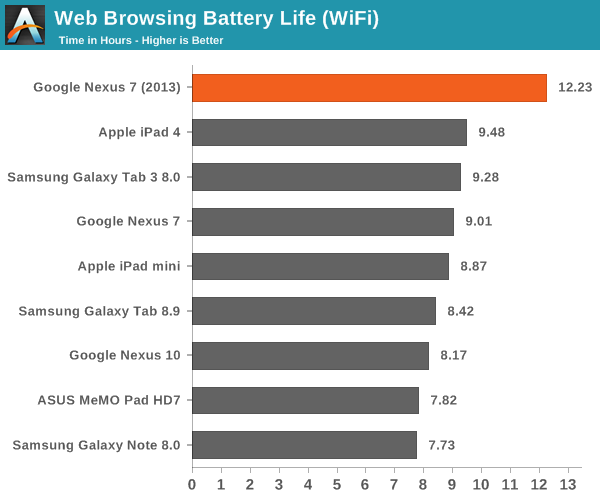
The new Nexus 7 does better here than any other small tablet we've ever tested. Remember that 50% decrease in idle platform power? That's exactly why we're seeing a 35% improvement in battery life compared to the original Nexus 7.
Our video playback test involves looping the playback of a 4Mbps 720p High Profile H.264 transcode of the last Harry Potter Blu-ray. All displays are calibrated to 200 nits.
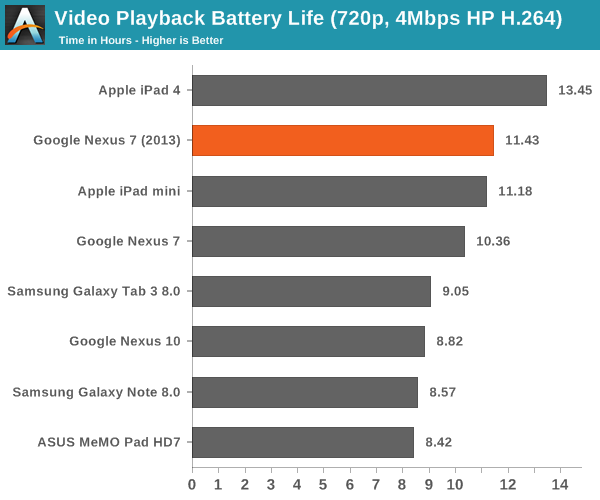
Video decode blocks are fairly well optimized to begin with, so there's not a ton of room for improvement here compared to last year's Nexus 7. Despite the ~7% shrink in battery capacity, the new model manages a 10% increase in battery life though. We also have the first small Android tablet capable of beating the iPad mini in a video playback test here - job well done ASUS/Google.
Our final test involves looping the Egypt HD benchmark until the battery is completely drained. Frame rates are capped to 30 fps to somewhat simulate actual gameplay and not penalize faster GPUs.
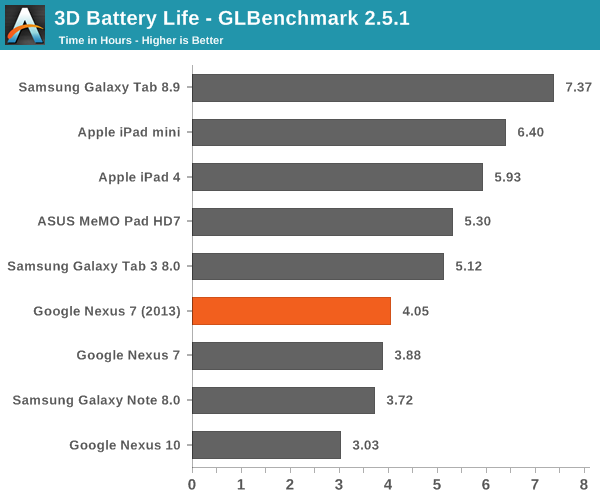
The new Nexus 7 manages to deliver slightly better battery life here despite driving higher frame rates and more pixels. Overall performance here isn't anything super impressive, the only average showing from the Nexus 7.
Google ships the Nexus 7 with an ASUS branded 7W charger, identical to the one you'd find in the box of a MeMO Pad HD7. Given identical chargers and battery capacities, there's no surprise the new Nexus 7 takes the same amount of time to charge as the MeMO Pad HD7 (~3.5 hours).
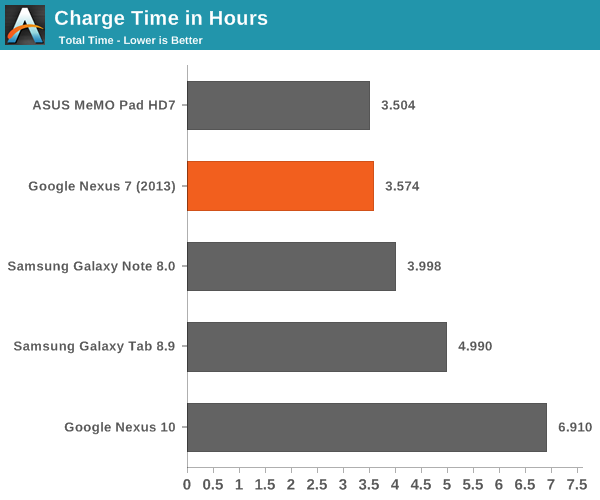
The new Nexus 7 also supports wireless charging by implementing the Qi standard. Charge time is a bit slower wirelessly as Qi can only charge at up to 5W. Brian tested Qi functionality in his mini review of the Nexus 7 and didn't have any issues.


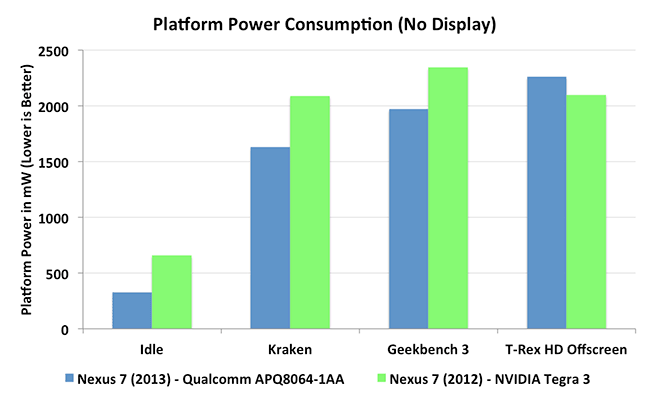









202 Comments
View All Comments
coldpower27 - Thursday, August 22, 2013 - link
Though bare in mind iPad mini is an old device due for a refresh in the Fall. A Retina display version, with a lower power A6X chip would do wonders. Unless you really love iOS, and the features Apple gives with their product, spec wise the Android tablet has them beat. But specs has never been all that is important when it came to these products. User experience is still key.looper - Thursday, August 22, 2013 - link
Coldpower27, I agree. Imagine the cost of a possible upcoming iPad Mini w/ Retina display.I wonder how much bigger one can make the default font size on the new Nexus7. My eyesight is not the best.
Oh, BTW, the word is "bear", not "bare"; and "specs *have* never been", not "has never been"... sorry.
mmarafie - Friday, August 23, 2013 - link
Yes of course :) When the new iPad mini is released that's when you'll see the Anand compare directly with the Nexus 7, and talk about how amazing the CPU/GPU in the mini are while again omitting mention of the price difference (probably double the cost of the N7) or any other strengths the N7 might have (higher ppi, more RAM, faster CPU etc).I'm still waiting for the review of the Nexus 10 which got released last year around the same time as iPad 4 (I own both), and the iPad 4 got the review in December while the Nexus 10 just got a preview.
weiran - Friday, August 23, 2013 - link
> any other strengths the N7 might have (higher ppi, more RAM, faster CPU etc).If a Retina iPad mini is released, it will have a higher PPI than this N7. And we all know that comparing specs in tablets is pointless if the comparison involves different OSes.
mmarafie - Friday, August 23, 2013 - link
Well define Retina please? If I'm not mistaken Apple considers 300 ppi and higher displays as Retina, yet the iPad 4 only has a 264 ppi display. The new Nexus 7 is over the 300 ppi magic number at 323. For the iPad mini to have a higher ppi than that it will need a higher resolution screen than the full HD one of the N7. It will need the same resolution as the iPad 4 (2048x1536) or higher. Its possible the new iPad mini will be released with a high res screen so we'll have to wait and see.kascollet - Saturday, August 24, 2013 - link
Retina is an Apple world, they can put it on whatever device they want but it always means :- pixels not visible at usual distance (more than 300 for a phone, more than 200 for a laptop, I between for a tablet...)
- high res is obtained by quadrupling the pixel count and thus conserving screen ratio and graphical elements size (makes all apps immediately compliant).
So if a Retina iPad Mini is made, it WILL feature a 2K x 1.5K resolution like the iPad 4.
retrospooty - Saturday, August 24, 2013 - link
"Retina is an Apple world, they can put it on whatever device they want but it always means :- pixels not visible at usual distance "
With a disclaimer - for 20/20 vision... Which is average eyesight, not above and not at all amongst the best. Most people with better eyesight may out around 400-450 DPI at 12 inches - some even higher.
Fri13 - Thursday, November 14, 2013 - link
20/20 is for normal eye sight, and it is the for most people.For most people (<90%) the 300 DPI at 20cm distance is more than enough, they can not see differences between that and 150 DPI without using magnification glass (lope actually) and compare exactly same content. With PPI there is no difference either unless you start looking trough very small details like in fonts from distance of 5-10cm and it isn't good for your eyes anyways. At normal viewing distance with tablet is 35-40cm.
When it comes to very good eye sight, last time what I read about the record (over decade ago) it was that a person could detect 6mm long string from distance of 2km, would be like display should have so high resolution that its density would be over 1.5 million on inch. But not even then a person with great eye sight could care less does display have a 150 PPI or 300 PPI.
I had once a friend and her eye sight was very good, she could read a normal news paper font (10-11 points) from distance of 20 meters. You couldn't not believe it without being there testing it. It was just jaw dropping that you could take any page and present it to her from 20m distance and she could read it a loud (we didn't test longer distance). But it was amazing how she could read a traffic signs text from few kilometer distance. It was like having a hawk what can talk to you.
The most important part in display pixel density is that font is rendered in manner it is clear to read. So you don't mistake letters and you don't need to spend much time quessing what letter is what.
Like how many is whining about 72-90 PPI in their workstation/laptop displays? They can read it perfectly fine, they don't find them disturbing to have much lower pixel density in their much bigger computer screen, but then they whine about smartphones and tablets if it is below 300 PPI.
retrospooty - Saturday, August 24, 2013 - link
"Well define Retina please?" - Retina is a marketing name Apple came up with for higher res screens. Apple fans, being a mostly non-technical bunch think it means something, but its arbitrary specs are just that... Arbitrary. 330+ isnt the end all be all of the DPI usefullness. The average eye cannot detect pixels at much higher DPI, but the other 1/2 of the world with above average eyesight can. IF you can see pixels, the higher hte better. If you cannot, save your $$$ and get something cheaper.abazigal - Saturday, August 24, 2013 - link
Retina is actually a combination of both PPI and distance of the screen from your eyes.Apple would probably explain that since users tend to hold the ipad further away from their eyes compared to a smartphone, the ipad4 can still be considered retina despite its lower PPI.
The ipad mini will likely have the same 2048x1536 display to maintain backwards compatibility with existing ipad apps. That gives it a PPI of 324 (same as iphone), putting it on par with the Nexus7.
My, hardware certainly has come a long way.